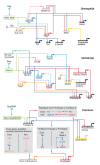Use with caution: developmental systems divergence and potential pitfalls of animal models
- PMID: 19562005
- PMCID: PMC2701150
Use with caution: developmental systems divergence and potential pitfalls of animal models
Abstract
Transgenic animal models have played an important role in elucidating gene functions and the molecular basis development, physiology, behavior, and pathogenesis. Transgenic models have been so successful that they have become a standard tool in molecular genetics and biomedical studies and are being used to fulfill one of the main goals of the post-genomic era: to assign functions to each gene in the genome. However, the assumption that gene functions and genetic systems are conserved between models and humans is taken for granted, often in spite of evidence that gene functions and networks diverge during evolution. In this review, I discuss some mechanisms that generate functional divergence and highlight recent examples demonstrating that gene functions and regulatory networks diverge through time. These examples suggest that annotation of gene functions based solely on mutant phenotypes in animal models, as well as assumptions of conserved functions between species, can be wrong. Therefore, animal models of gene function and human disease may not provide appropriate information, particularly for rapidly evolving genes and systems.
Figures



References
-
- Lieschke GJ, Currie PD. Animal models of human disease: zebrafish swims into view. Nature Reviews Genetics. 2007;8:250–267. - PubMed
-
- Rosenthal N, Brown S. The mouse ascending: perspectives for human-disease models. Nat Cell Biol. 2007;9(9):993–999. - PubMed
-
- Hau J. Animal models for human disease. Berlin, Germany: Humana Press Inc.; 2008.
-
- Koonin EV. Orthologs, paralogs and evolutionary genomics. Annu Rev Genet. 2005;39:309–338. - PubMed
-
- Amundson R. The changing role of the embryo in evolutionary thought: roots of Evo-Devo. Cambridge: Cambridge University Press; 2005.
Publication types
MeSH terms
LinkOut - more resources
Full Text Sources
Other Literature Sources
